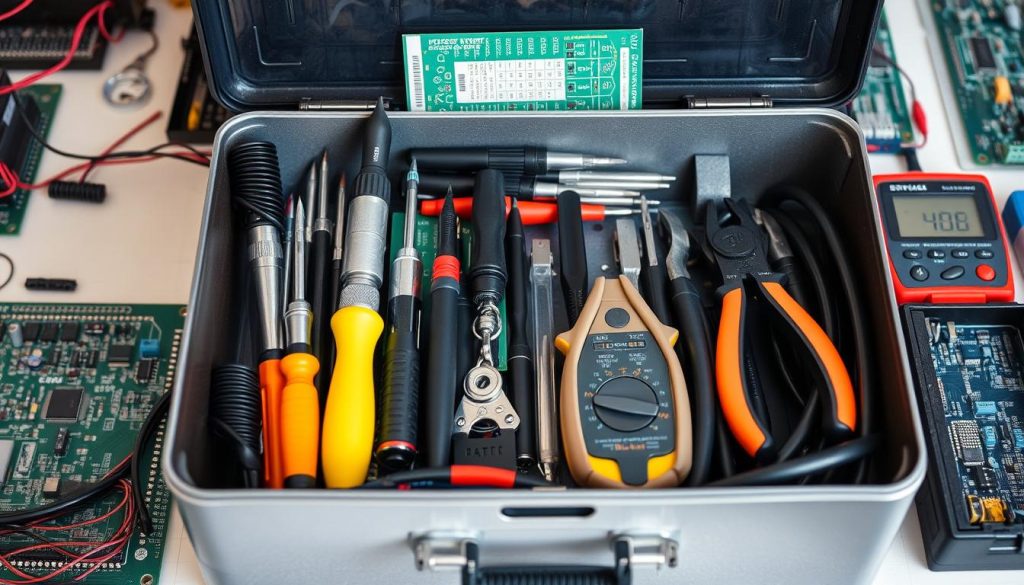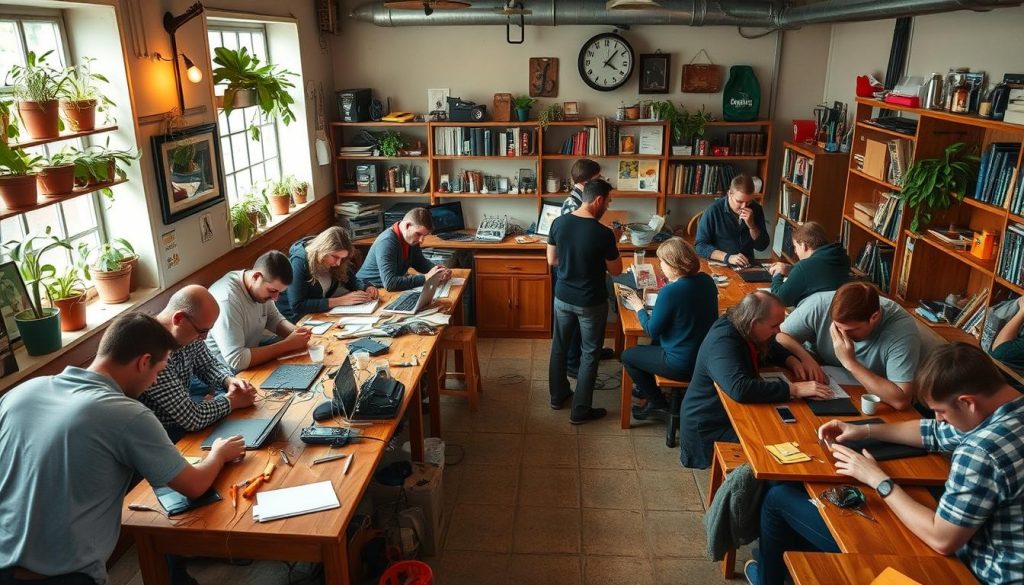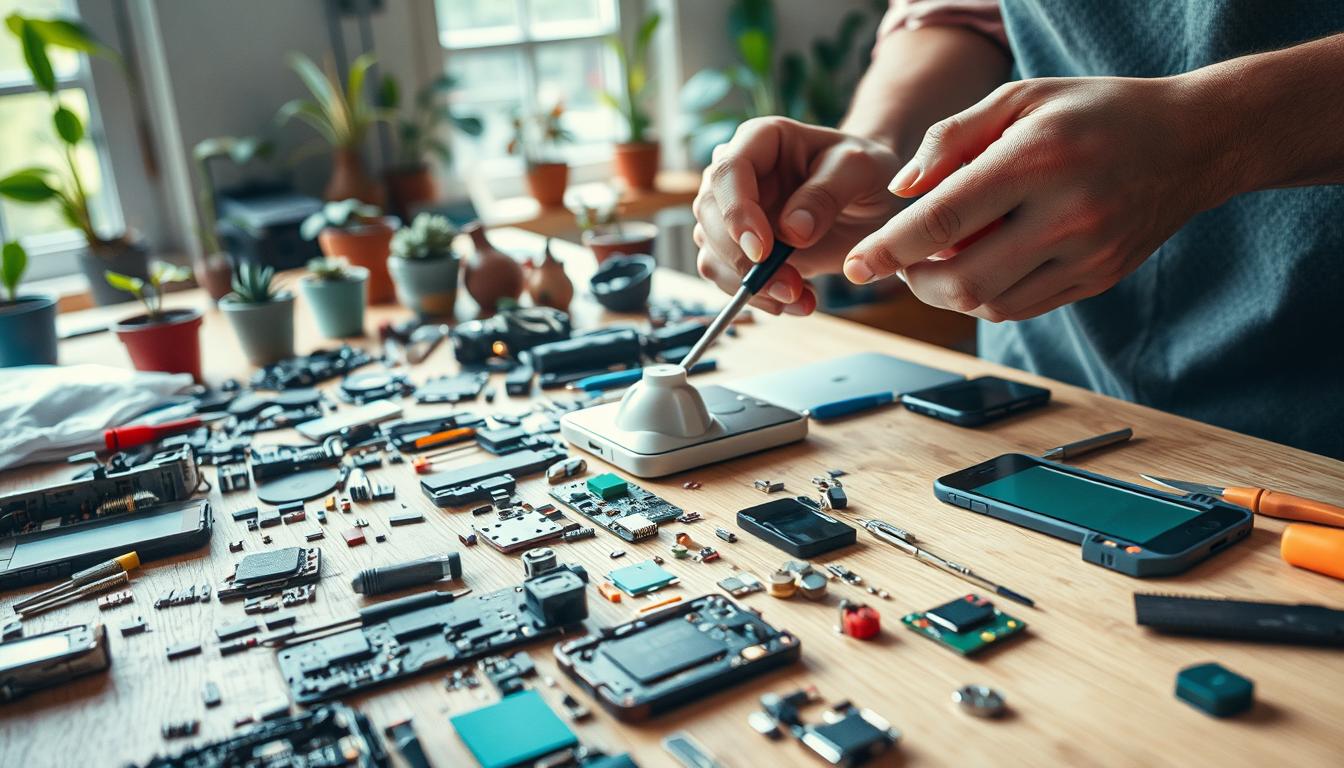I’m passionate about reducing electronic waste and promoting repair. In this guide, I’ll share my experiences and tips. They’re designed to help you join the repair movement and support a greener future.
E-waste harms our environment, and fixing electronics is key to solving this problem. By learning to repair devices, we can make them last longer. This saves resources and keeps many products out of landfills. In the next parts, I’ll explain why repair is important, show you which devices can be fixed, and teach you how to do it yourself.
Understanding the Importance of Repairing Electronics
I started repairing electronics because I was curious about how they work. I learned about Green Technology and the Circular Economy. I saw how fixing electronics helps the environment and our future.
Environmental Impact of E-Waste
E-waste is a big problem that needs our help. Every year, millions of tons of old electronics go to landfills. This harms our planet and pollutes it with toxins. Fixing our devices can greatly reduce e-waste, making our future greener.
Benefits of Repairing Over Replacing
- Reduced environmental impact: Fixing electronics saves natural resources and cuts down on carbon emissions from making new ones.
- Cost savings: It’s cheaper to fix a device than to buy a new one. This way, you get more life out of your electronics.
- Skill development: Repairing electronics is a great way to learn. It helps you gain technical skills and understand the devices we use.
Repairing electronics is my way of helping the planet. I follow Green Technology and the Circular Economy. I want to encourage others to fix their devices too. Together, we can lessen the harm of electronic waste.
Common Electronics That Can Be Repaired

I’m passionate about eco-friendly electronics and the right to repair. Many devices, like smartphones, laptops, and appliances, can be fixed instead of thrown away. This approach helps extend their life and reduces waste.
Smartphones: A Lifeline in Repair
Smartphones are essential in our lives, and replacing them is costly. But, many problems can be fixed with the right tools and knowledge. Cracked screens and broken buttons are common issues that can be solved.
Repair cafes and online forums have been great resources. They help me fix my phones, saving money and reducing waste.
Laptops: Why I Fix Rather Than Toss
Laptops can also be repaired instead of replaced. Issues like faulty batteries and broken hinges can be fixed. This approach is both affordable and good for the environment.
By learning basic repair skills and finding parts, I’ve made my laptops last longer. This helps avoid frequent replacements and supports the Eco-friendly Electronics movement.
Household Appliances: The Unsung Heroes
Appliances like refrigerators and washing machines are often ignored when it comes to repair. But, with some effort and the right tools, they can be fixed. This saves money and reduces landfill waste.
Repair cafes have been key in teaching me how to maintain these appliances. They offer hands-on help and resources, making it easier to keep them working.
Embracing repair has changed my life. It helps the environment, saves money, and supports the Right to Repair movement. I hope my story encourages others to try repairing their electronics and enjoy the benefits.
Tools and Techniques for Successful Repairs

I love fixing electronics and have learned that the right tools and techniques are key. Whether it’s a smartphone or a household appliance, knowing the basics is essential. This knowledge helps me repair devices in a way that’s good for the planet.
Essential Tools for My Repair Toolkit
I’ve built a set of tools that are vital for my repair work. This includes:
- Precision screwdriver set for delicate disassembly
- Multimeter to diagnose electrical issues
- Soldering iron and solder for component replacement
- Tweezers and magnifying glass for intricate work
- Electrostatic-safe workstation to prevent damage
Basic Techniques for Beginners
Starting out in electronics repair? No worries! There are simple techniques to learn. Here’s where to begin:
- Careful disassembly to access internal components
- Visual inspection for obvious signs of damage or wear
- Testing components with a multimeter to identify issues
- Soldering replacement parts with precision and care
- Reassembly and testing to ensure the device is functioning properly
Safety First: Precautions I Always Take
Safety is always my first concern when repairing electronics. I follow these important steps:
- Wear anti-static gloves to prevent static discharge
- Disconnect devices from power sources before working on them
- Properly dispose of old components, adhering to green technology guidelines
- Maintain a clean, well-lit workspace to minimize accidents
- Stay up-to-date on safety protocols for handling electronic devices
With the right tools, basic techniques, and a focus on safety, I can handle many repair jobs. This not only keeps my devices working but also supports my green technology goals.
Finding Resources and Community Support

Exploring the world of electronics repair has opened up a lot for me. I’ve found many resources and a community of people who share my interests. Online forums and local Repair Cafés have been key in improving my skills and connecting with others.
Online Forums and Communities I Rely On
For tough repair jobs or advice, I go to online forums like iFixit and Repair Cafe International. These places are full of knowledge, thanks to experienced techs and DIY fans. The community spirit here is truly uplifting.
Repair Cafés: Getting Hands-On Help
Local Repair Cafés are another great resource. These events bring together volunteers and people needing help fixing their items. It’s been a huge help, letting me learn from experts and get practical experience.
Educational Resources that Have Helped Me
Many educational resources have helped me grow. Sites like iFixit and Repair.org have great tutorials and guides. Libraries, colleges, and workshops are also great for learning and practicing.
Using these resources and joining the repair community has improved my skills. It’s also made me appreciate the Right to Repair and our role in a sustainable economy.
Celebrating the Repair Mindset
Thinking about my journey in electronics repair fills me with pride and purpose. Sharing my repair stories has been rewarding. It inspires others to help make our future more sustainable.
By fixing our devices, we can reduce the huge amount of e-waste harming our planet.
Sharing My Repair Experiences
Fixing a dead device makes me feel accomplished. It’s like giving an old friend a new lease on life. From fixing an old radio to saving a smartphone, each story shows our power.
By sharing these, I hope to motivate others to see the value in their devices.
Inspiring Others to Join the Movement
The repair mindset is more than fixing things. It’s about being resourceful and caring for our planet. Sharing my skills online and in local groups has inspired many.
Seeing others’ joy when they fix a device is what keeps me going.
Long-Term Sustainability: A Personal Commitment
My dedication to sustainable electronics goes beyond just fixing things. I aim to reduce e-waste and promote eco-friendly electronics. It’s not just a hobby; it’s a way of life that reflects my values.
It drives me to keep learning and inspiring others to do the same.

